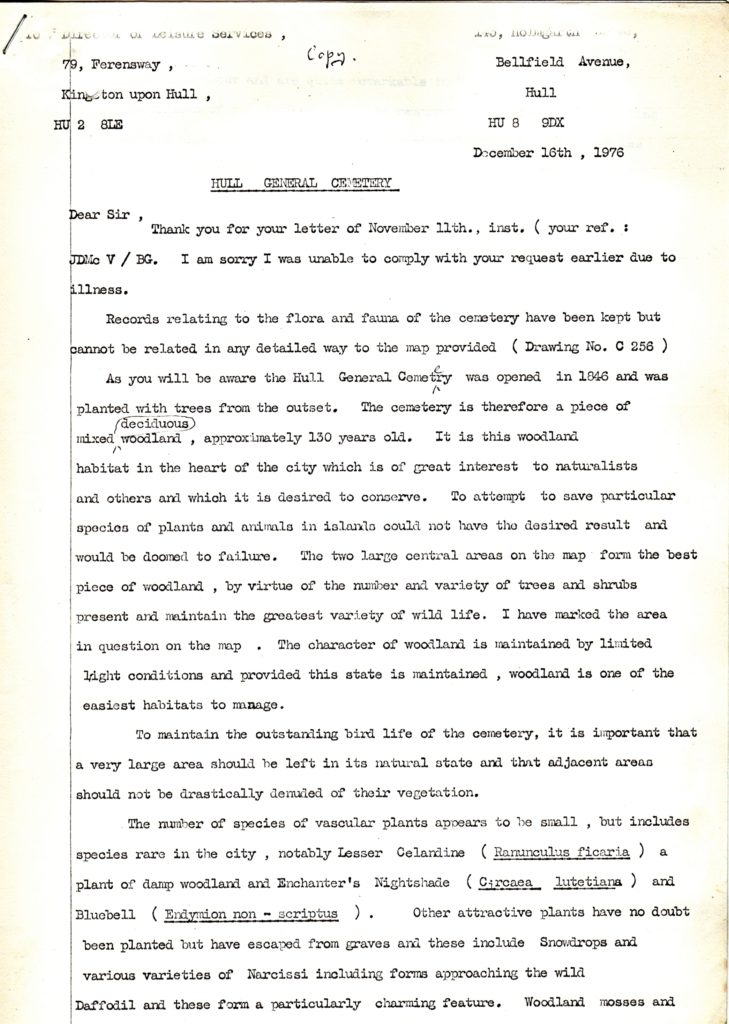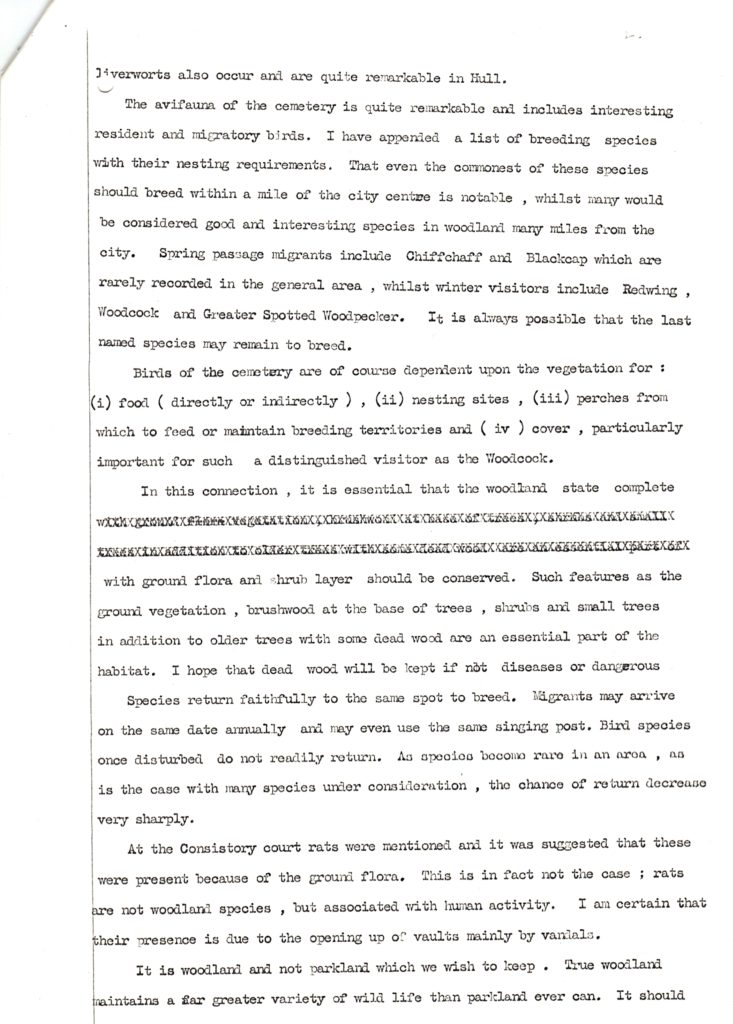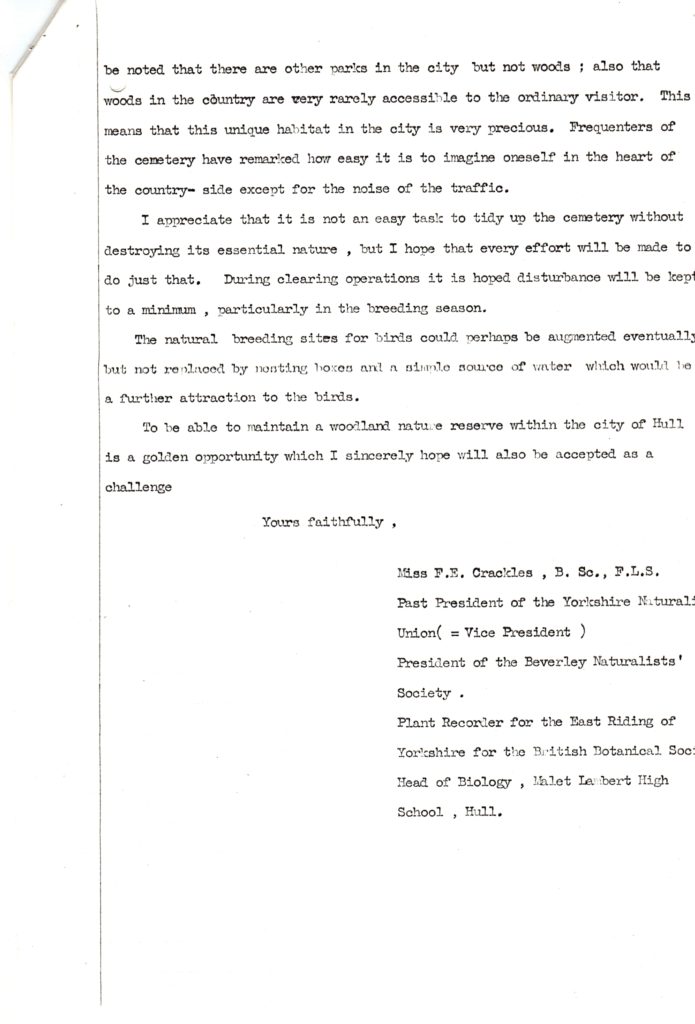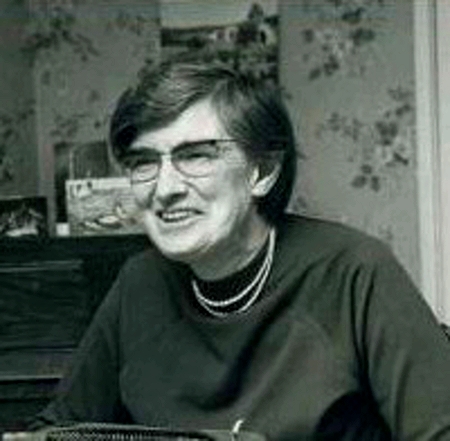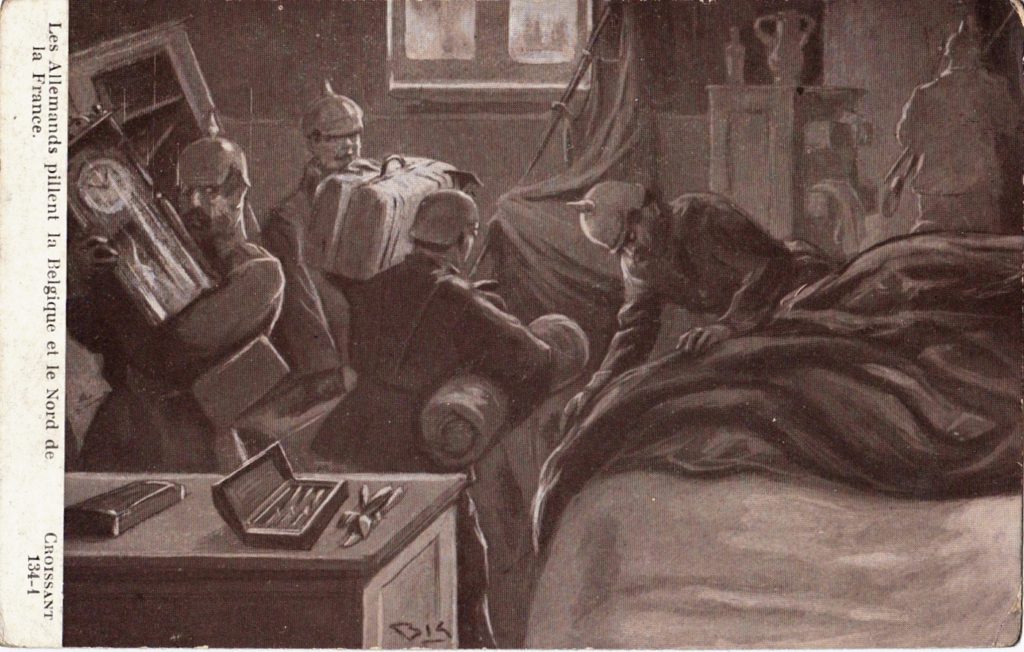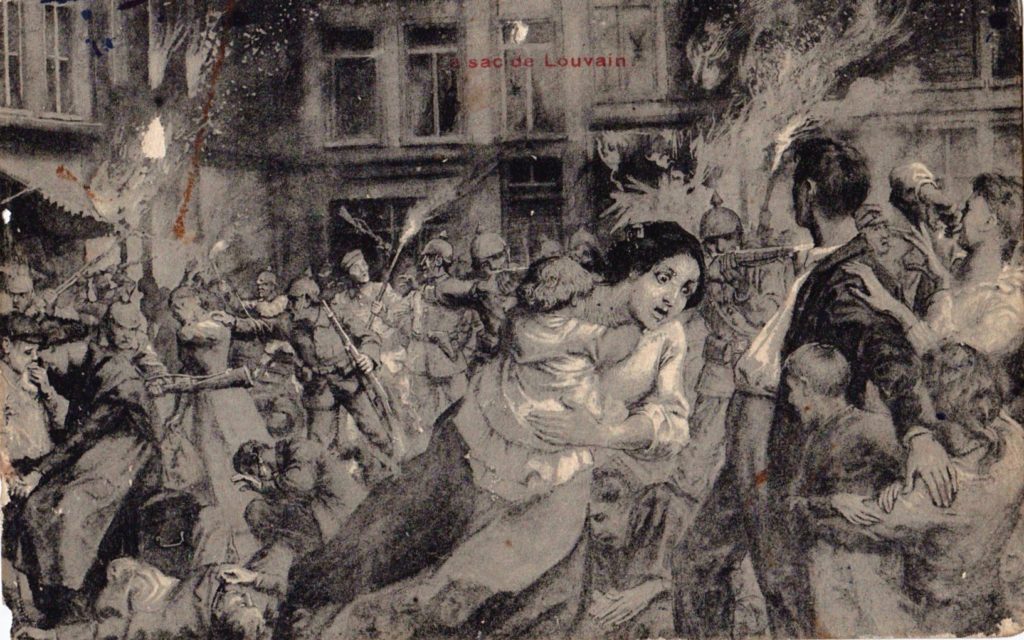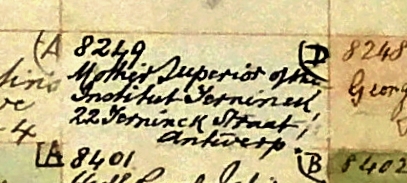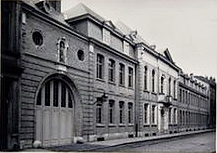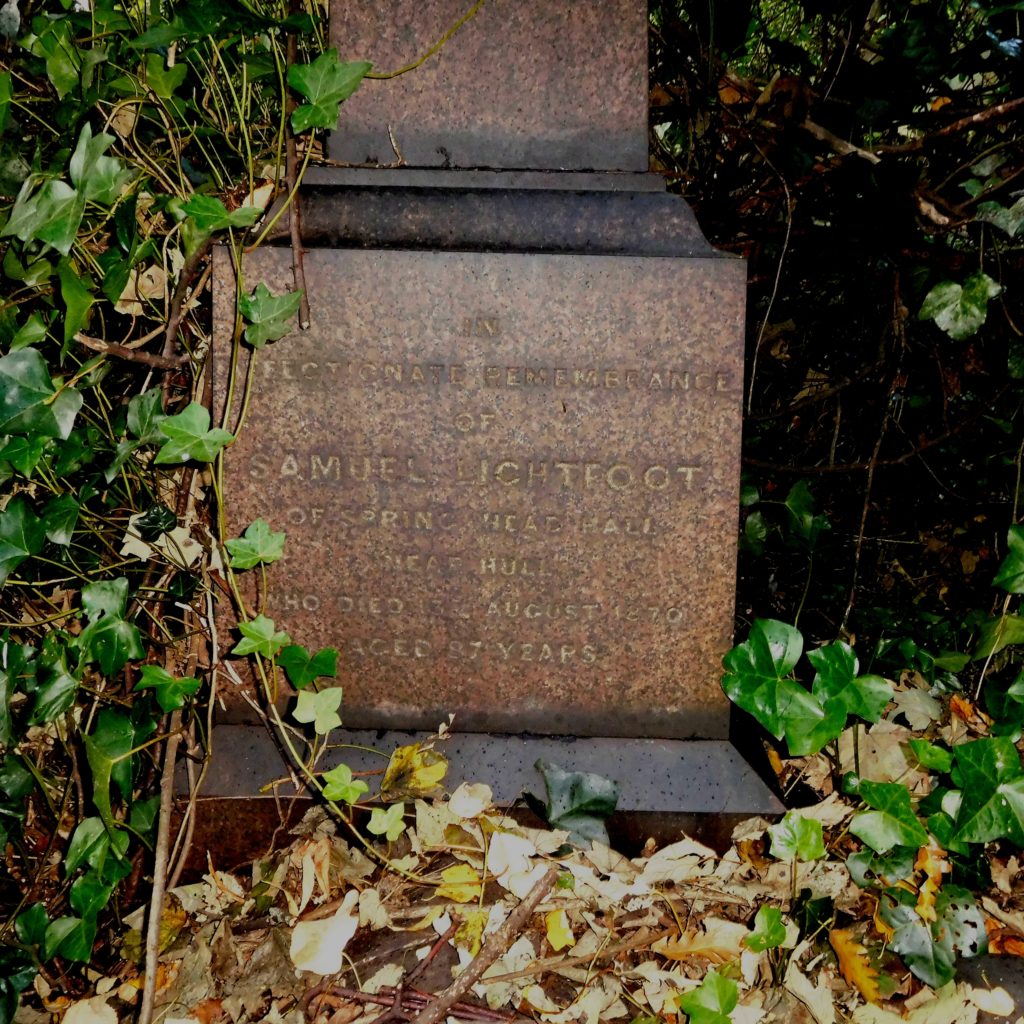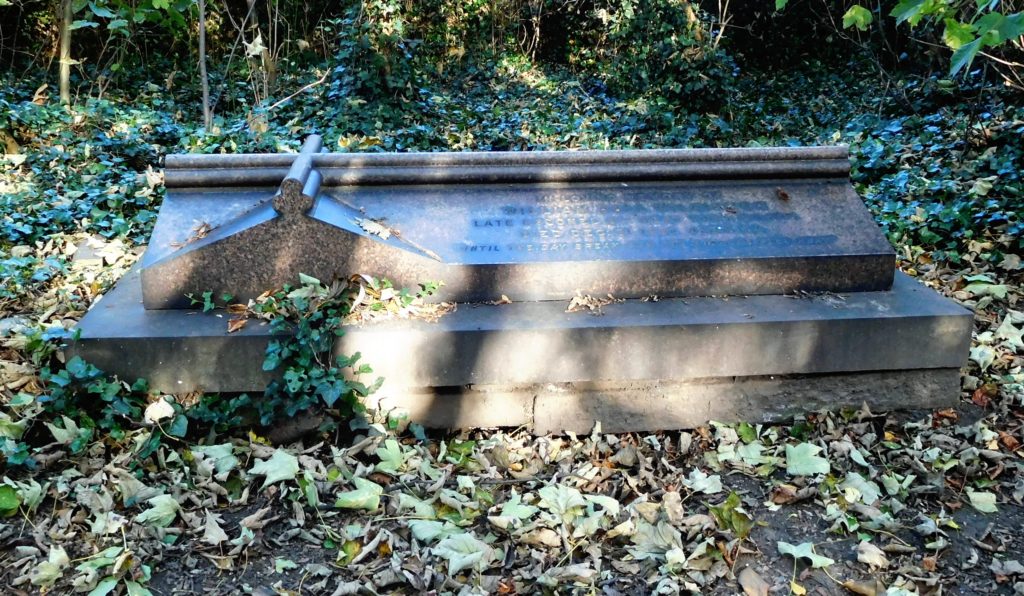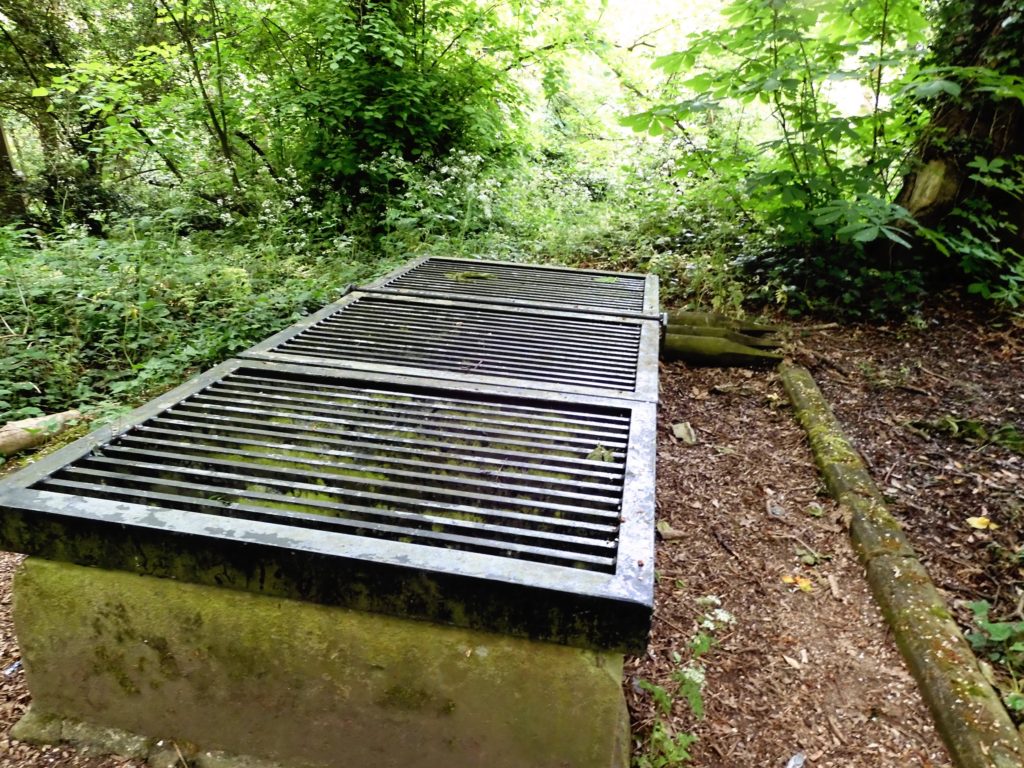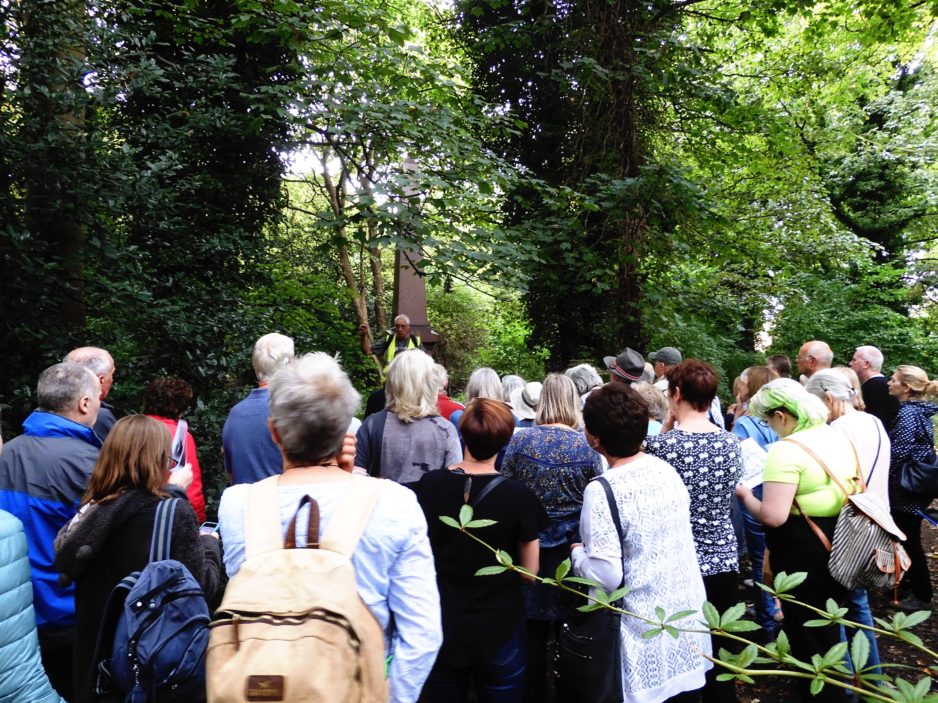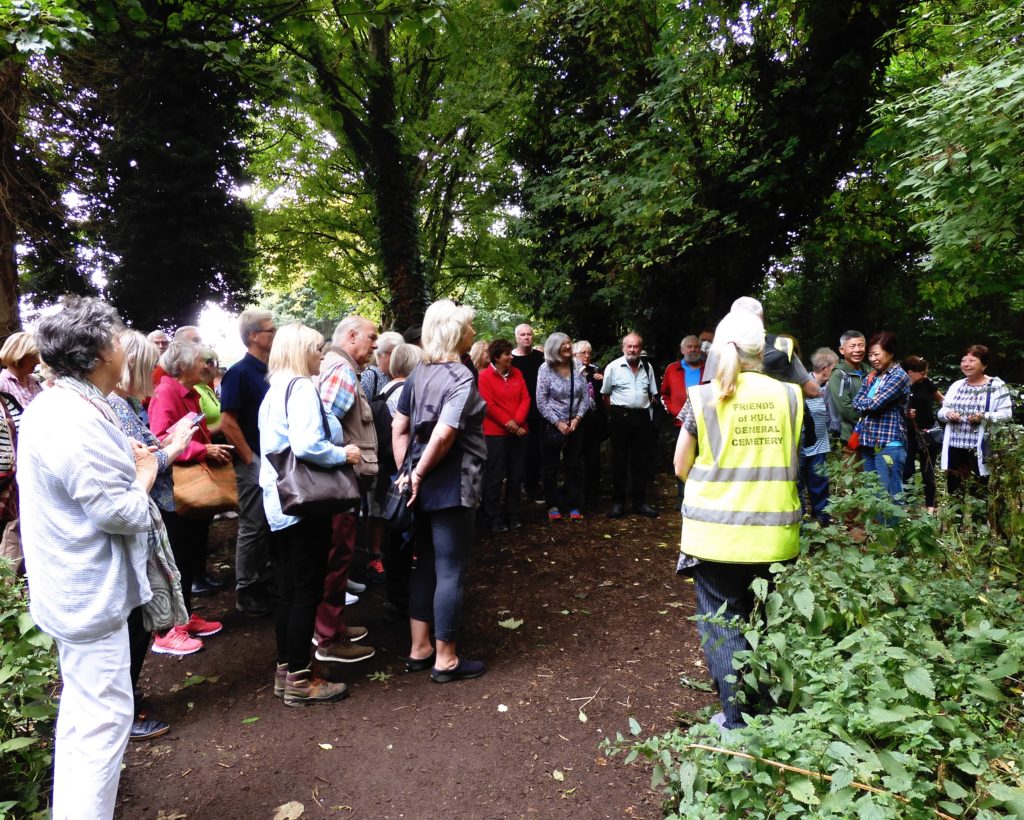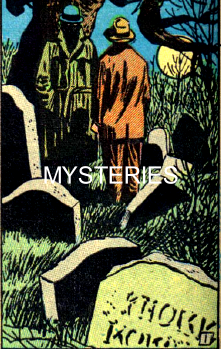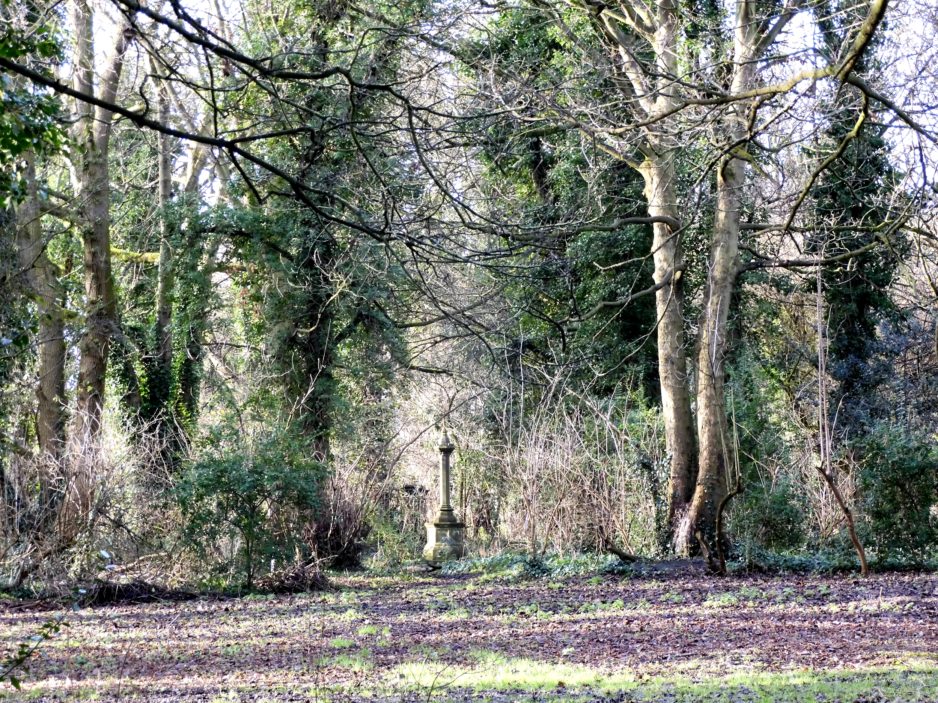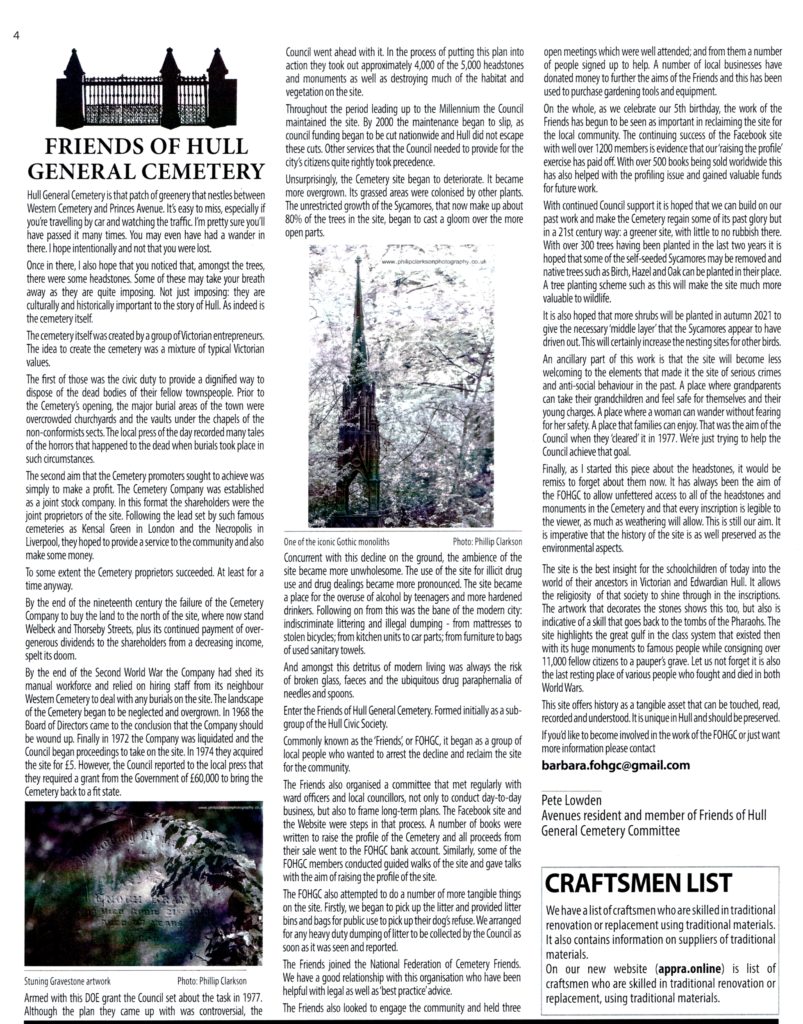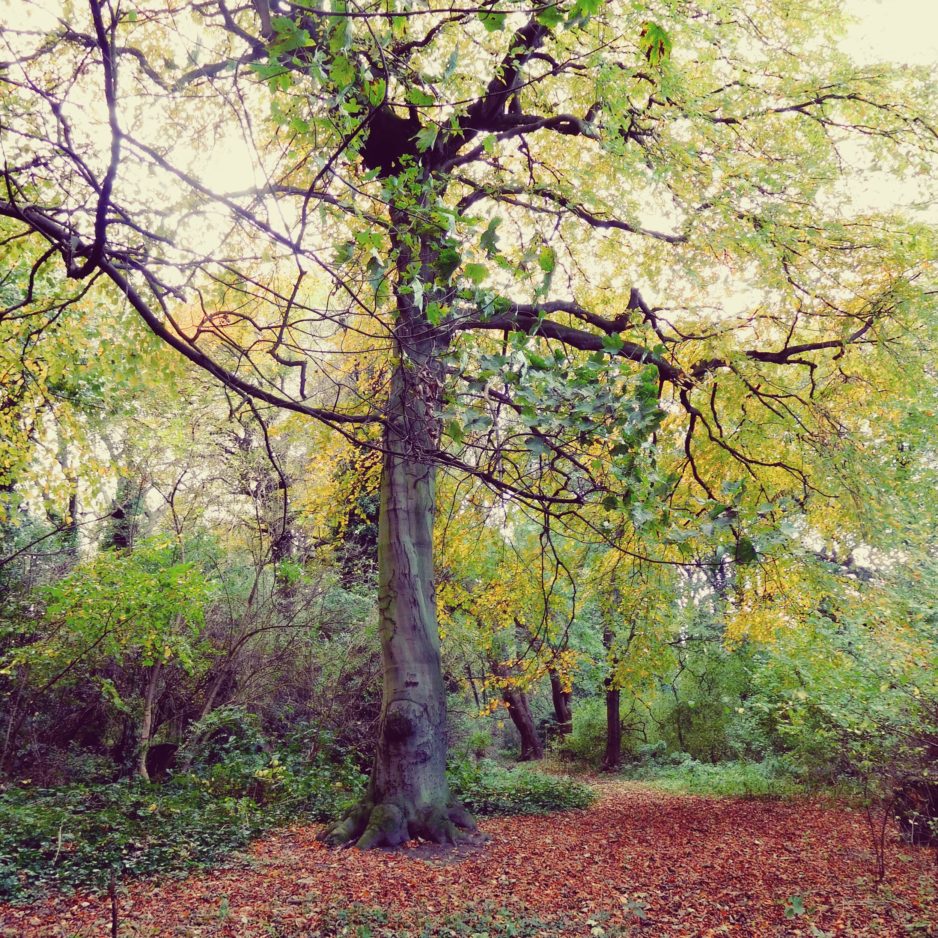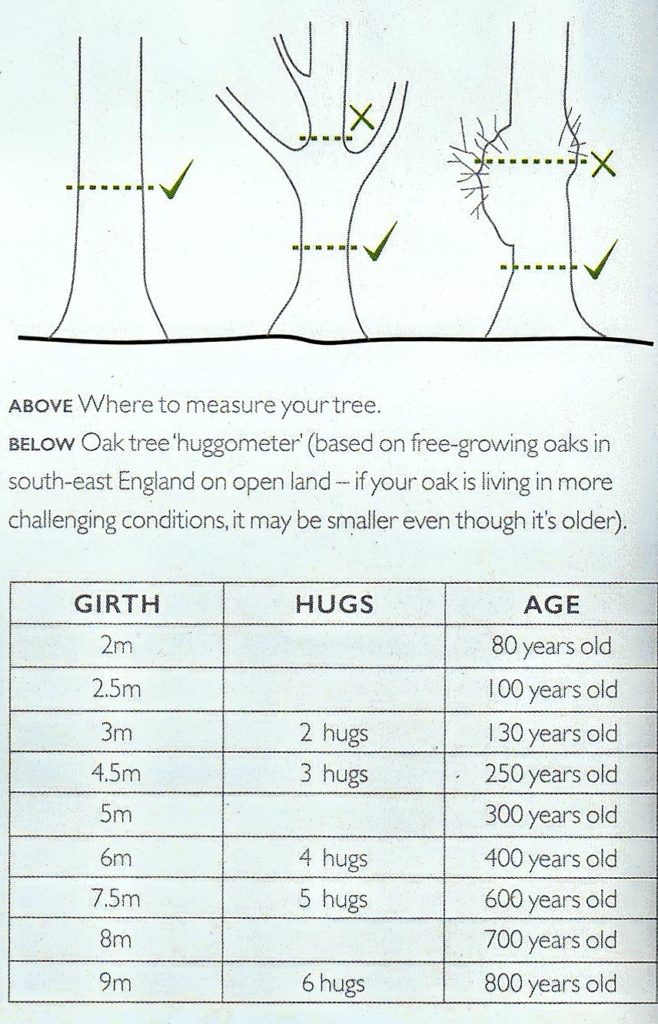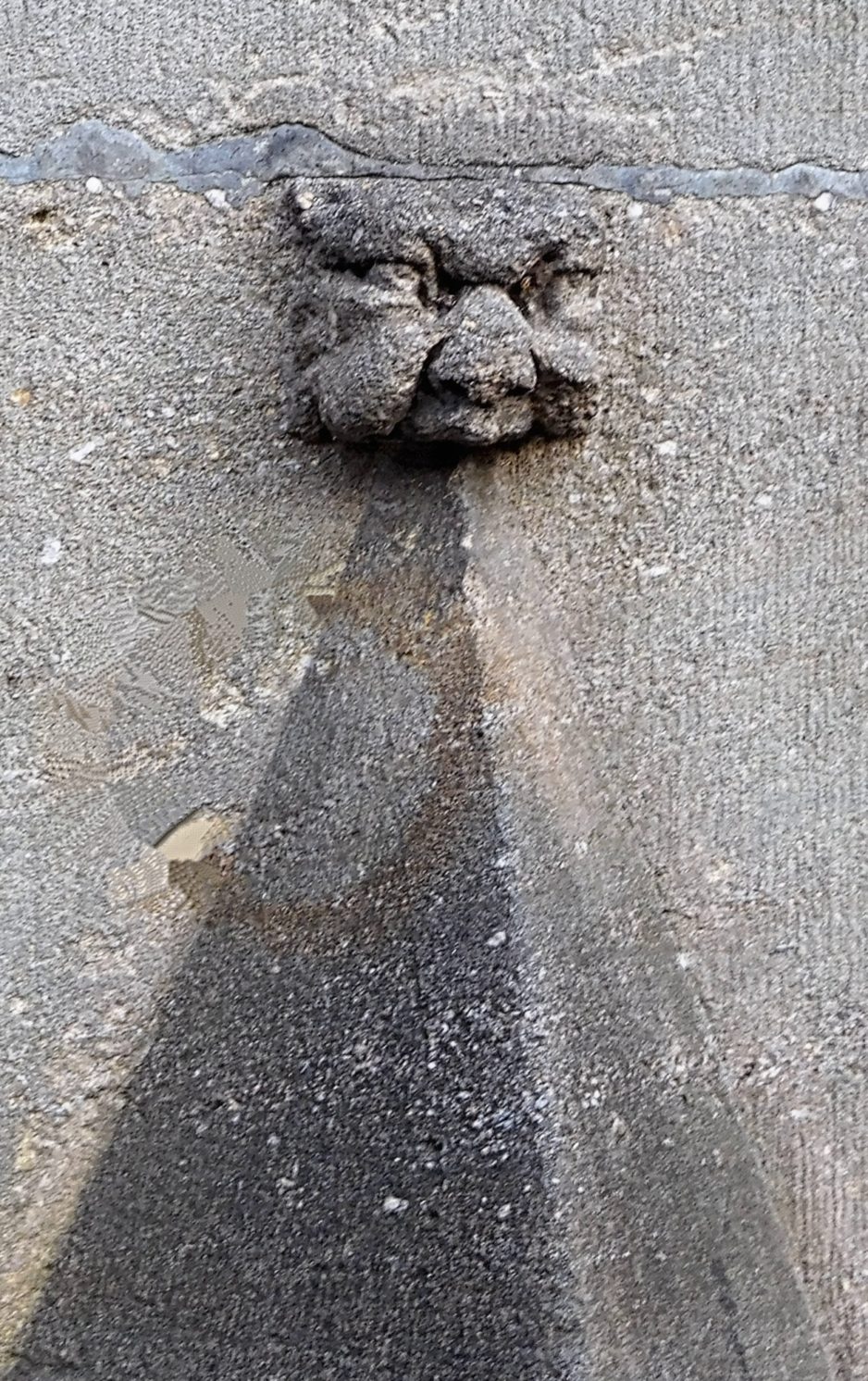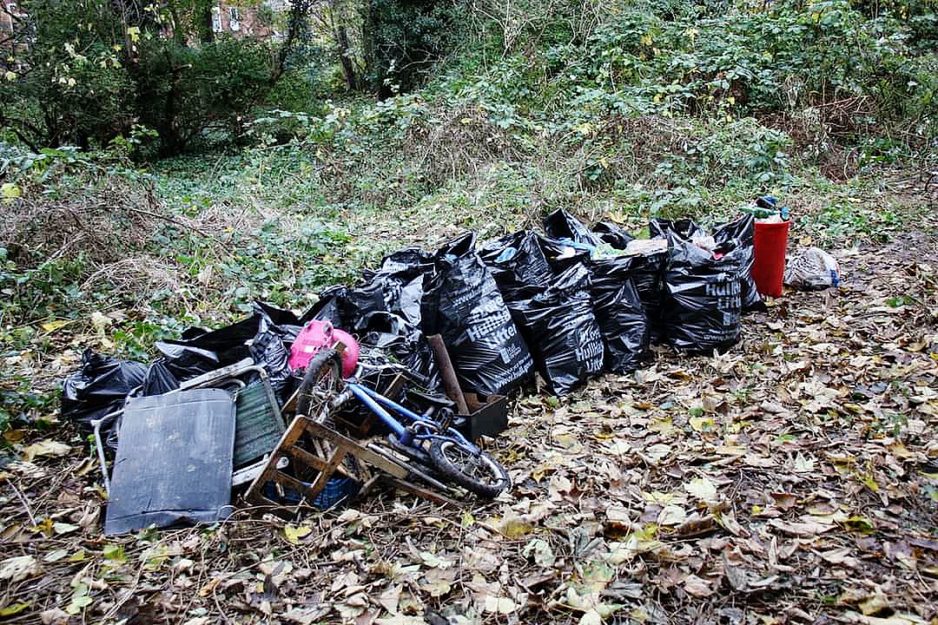A couple of years ago I was told that there was to be a talk at the History Centre. It was entitled ‘The Mysteries and Secrets of Hull General Cemetery’. I thought I’ll pop along to that. I’m always open to increase my knowledge of the site
About a couple of months before the talk I was in the History Centre. Chatting to the staff I was told by the person who usually books the monthly talks that she was sorry. She said HGC was usually my topic and that the booking had happened whilst she was off ill. I was touched by this nod to my idiosyncrasy. I said I was happy to share the topic but I was intrigued as to what the mysteries and secrets were, as to my knowledge, there were very few if any. She nodded.
It was common knowledge amongst the staff there that I had copied or photographed every item that they possessed about Hull General Cemetery and that I had acquired a few things myself that they didn’t possess.
As it turned out the talk didn’t talk about any mysteries or secrets in HGC. Don’t get me wrong here. It was a good, well researched talk and it definitely had lots of visuals to keep the punters happy. But the ‘mysteries and secrets of Hull General Cemetery’, well, I’m afraid there was little sign.
Not Hollywood
That circumstance lies in the fact that the life of HGC is not a movie script. Harrison Ford does not uncover the catacombs of the ‘lost chapel’. Sam Neil, whilst cutting back the brambles, does not find he’s walked into a velociraptor nest. No, sorry. Highly unlikely. Much more likely is that Harrison Ford would find the remains of a shooting-up drugs gathering or that Sam Neil would tread in some maggot ridden kebab.
Yes, there are stories within the cemetery. Stories of its trials and tribulations. Stories of the people who are buried there. But it is not the Marie Celeste. It is not Area 51. It is not the X-Files. The truth isn’t ‘out there.’ It’s a shame but that’s the way it is.
The real Secrets and Mysteries
The secrets and mysteries, if they exist, are found in far more mundane places. They are written in numerous documents. These documents take a lot, and I mean hundreds of hours, of painstaking research to extract that small nugget of information you are seeking. And this process takes a number of years. At the end, the result may be as unexciting as finding that a miscalculation on the part of some clerk a century ago can now be cleared up. But to someone with that penchant for ‘the truth’ it;s like gold dust.
I did mention my idiosyncrasy, didn’t I?
So, with my Harrison Ford / Sam Neil hat on, I have entered this dangerously tedious world many times.
There are two mysteries I’d like to put forward. The first one is about the mystery of Thomas Skerrow and, to add background, the rest of his family. The second one could be titled, ‘What did they do with bodies?’ You’ll understand when you read it.
In some ways these mysteries are mundane and perhaps only of interest to someone like me with that specific ‘nerdiness’ mentioned above but they are mysteries. And I can’t confidently say I have solved them. Yes, I know that my solutions are the most likely yet something still bugs me. See what you think.
Thomas Skerrow
Thomas Skerrow was a gravedigger. You should all know by now my affinity with such people. One could say that it’s in the blood but thankfully it isn’t. Other wise I’d probably be dead from tetanus or anthrax by now. Quite nasty soil borne diseases. No thank you.
Not in the blood but I do have some understanding of these under sung heroes’ roles. And indeed the stresses that were placed upon them. A Grave Digger
Thomas Skerrow had been employed by the Company since its inception in 1847.
As I’ve mentioned before, the workforce of the cemetery, received less than star billing in its production. I suppose that’s why I want to highlight them. Without them the Company would have failed, and the citizens of Hull would have had to put up with the horrific conditions of burial that took place prior to the HGC.
His death
We first learn of Thomas Skerrow by his death. Here’s his burial entry in the HGC burial register.

He died on the 9th April 1854 and was buried on the 12th.

Edward Skerrow, his father
The family already had a family grave as his father Edward had died the previous November. This was a particularly sad case as his father committed suicide. His death resulted in a post mortem and the death reached the local press.
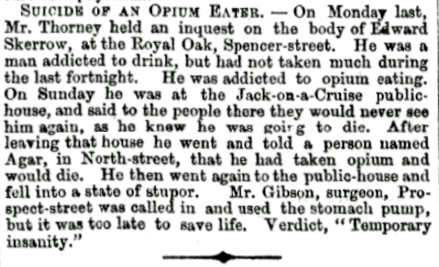
When Edward’s daughter Fanny married later that decade she was still so mortified by the death of her father she refused to provide her father’s name to the registrar. In the burial register of the Cemetery his cause of death is listed as ‘insanity’.
Cowkeeping
Edward Skerrow had been born at Tadcaster in 1791. He lived at 21, Canning Street and his occupation at his death was cowkeeper. Not as outlandish an occupation as we sophisticates of the 21st century would believe. It was quite common for small entrepreneurs to keep a number of cows. These could be hired out for breeding or when ready, sold for slaughter.
However the major source of income from keeping cows was milk. Milk was sold door to door to the gentry. The poorer classes often bought some too though mainly for weaning purposes. It was a thriving industry. Approximately where the old Edwin Davis Store stood in Bond Street was the site of a street called Milk Street because of the number of cows pastured there in the early 19th century..
Alan Harris, in his The Milk Supply of East Yorkshire, 1850-1950′, quotes F.M.Eden saying that in the closing years of the 18th century, ‘for 2 to 3 miles round‘ Hull land was devoted to grazing ‘for the convenience of the inhabitants.‘
Harris also states, and this is probably appropriate to Edward Skerrow, that,
‘Within the towns themselves, still smaller pieces of land were used for purposes that, if not strictly agricultural, must nevertheless have created in their vicinity an unmistakeable aroma of the countryside. {…} William Eleanor, another Hull Cowkeeper, occupied in 1851 a yard and a range of outbuildings behind residential property in North Street, Myton.’
Now Edward was in a fairly lucrative business if he kept his herd healthy. Plus he had a sizeable property as the map below shows so his herd may well have been quite sizeable too.
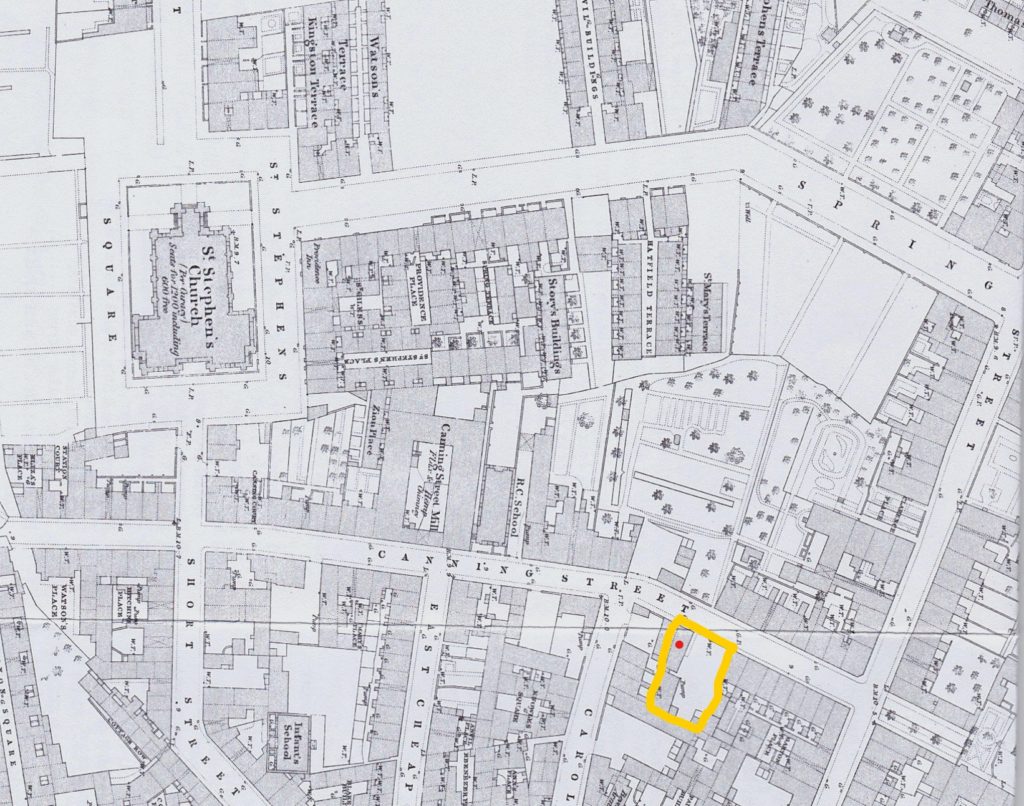
Yet, as the newspaper article above shows he was an alcoholic and an opium user.
Opium for the masses
Let’s be clear here. Opium was the drug of choice of many people then, from all classes. Queen Victoria enjoyed her laudanum as much as the workman who bought his pennyworth of opium for his pipe. It deadened the pain of living. It took away guilt, hunger and emotion. In Britain of the 1850s that was something to be cherished.
As for the alcohol, it was as readily available as was the opium. As were the public houses. You may note that Edward’s post mortem was conducted in a public house. This was that a public house was, in essence, neutral territory. It could accommodate the officials and the witnesses for such a gathering. It is only in the recent past that civic buildings have eclipsed the public houses in this role. Coroners, magistrates and other civic officials conducted their affairs from hostelries. It was felt less threatening and more fair.
The downside of that was that they were everywhere. So, if you had an issue with alcohol, then it would be difficult to avoid it.
Hannah
So, Edward Skerrow was dead. In death he left about £100 to his widow Hannah. By the 1861 census her son Edward junior had taken on the cowkeeper role and she disappears from the public eye for about 20 years.
She resurfaces in 1881, living in Hallgate, Cottingham and is described as a ‘property owner’. She died a year later and I’m sure no one could smell any trace of cows or manure at her funeral.
Of interest, the younger brother of Thomas, Edward, took over the Cowkeeping business from his mother some time in the late 1850s as mentioned above.
Prior to that he too worked for the Cemetery Company. In 1858 he found a box laid beside the cholera monument. Inside were two babies, born prematurely and probably dead at birth. The box was handed to the police who investigated but to no avail. Another mystery but probably all too common back then.
Back to Thomas
Back at Thomas. He died of a heart condition. The Company went as far as resolving to buy a headstone for his grave.
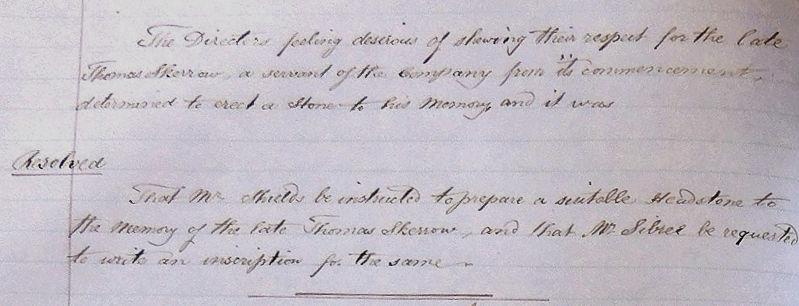
And now we come to the mystery. Or mysteries shall we say.
Firstly, there is no record of a stone being erected on the grave. From the entry above in the HGC minute books it appeared to be quite straightforward. A stone was to be erected and James Sibree, the Cemetery’s chaplain, was to write an inscription for the stone. Was it just forgotten? Quite unlikely. That the Company wanted to do something to mark Thomas Skerrow’s passing in the first place is unlikely but that they said they would and minuted this gives credence to the fact. So where was the stone? It wasn’t destroyed in the 1970s as far as we know. Did it ever exist?
No, I cannot solve this part of the mystery.
What compounds the mystery is this. In September 1858, the Board had given the tenants at the west end of the Cemetery notice to quit. One of these people, John Hill, sent a sharp letter to the board. The minute book tells the story.
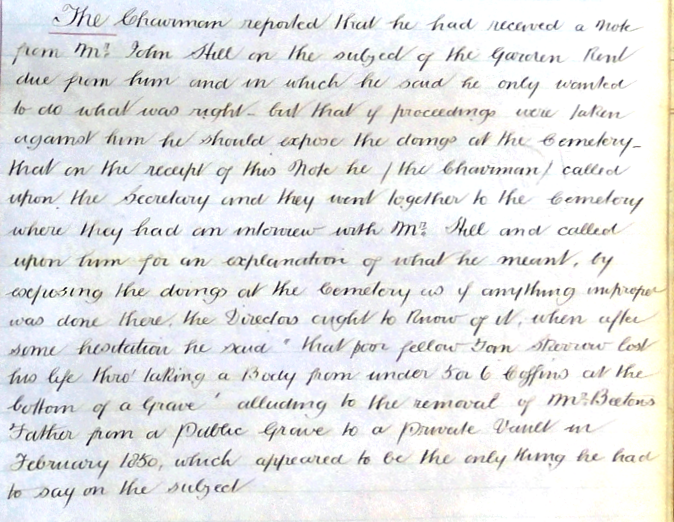
The Company under attack
Mr Thompson and Mr Todd, chair and secretary respectively of the Company, appeared to be unduly worried at this attack. Why? The man was behind in his rent. He had been given notice to quit. All was above board. That they both, busy men that they were, went to see Mr Hill shows something of the anxiety this letter from Mr Hill caused them. Again I ask why? The Cemetery was in fine shape and often cited as a boon to the town. What would such gentlemen care for the word of a disgruntled tenant? What harm could his tittle-tattle do?
We already know that Thomas Skerrow died from heart failure. He wasn’t crushed by any graveyard calamity was he? What was Mr Hill alluding to? Was the probable cause of death something he caught during this particular job that later affected his heart? Could any damage to Thomas’ heart have been caused during this particular task?
Ordinarily I would dismiss such questions. I have a death certificate and burial entry all saying the same thing. That’s gold plated in my book. But I still have that nagging doubt, simply caused by two of the major players in Hull at the time, going out of their way to discuss an irate tenant’s baseless claim. Both of these men were learned, C.S.Todd was a solicitor and later became the Sheriff of Hull. They could and should have laughed at this or possibly taken legal action. They did neither.
With my Probation Officer head on I find it’s just a little odd. What do you think?
Cholera
And the second mystery is shorter but more difficult. As most of you will know in 1849 cholera hit Hull for the second time.
The Cemetery fulfilled a public duty and buried the corpses in a timely and safe manner. To cater for the great mass of bodies the Cemetery Company set aside two full compartments and two halves. This was recorded in the Minute books of the 9th August 1849.

As can be seen from the map below taken from the Cemetery records the compartments chosen were 96,97,122 and 123.
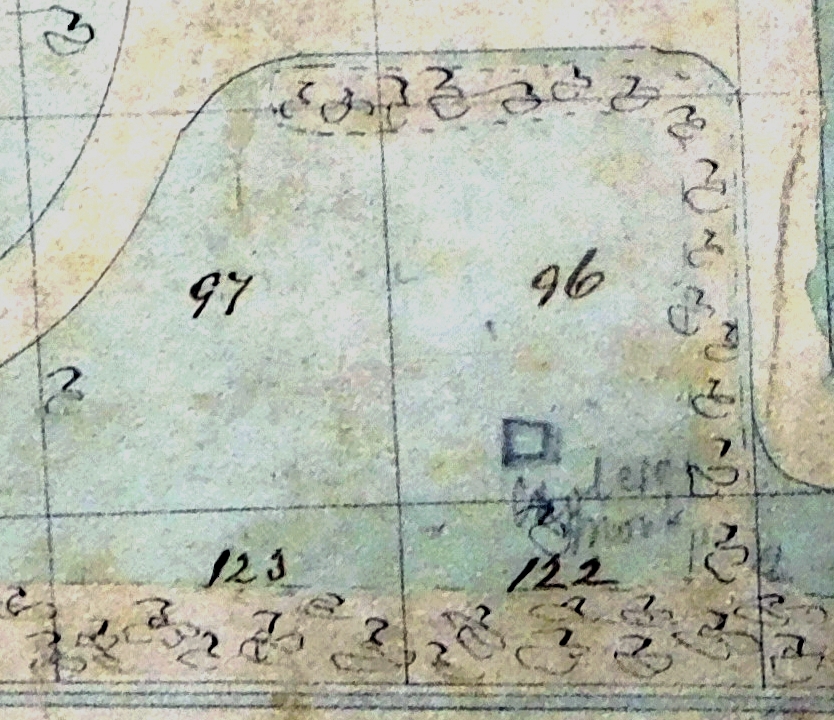
The Cholera monument was erected in Compartment 96. All fine so far.
The problem
Now we come to the problem. Many of the people who died from cholera were not buried in those plots. Yes, if a family grave had already been purchased the relative could be buried irrespective of the cause of death. What is more surprising is that many of the burials in the portion assigned to the Cholera ground appear to have been in Compartment 121.

Unfortunately there is no Compartment 121 in the Cemetery except for a rump that was sited under what is now the shops on Princes Avenue. So, what’s going on?
That this issue was not noticed for 50 years is surprising. Michael Kelly, the last Superintendent, noticed it and remarked on it during his tenure. But it was obviously a mystery to him too.
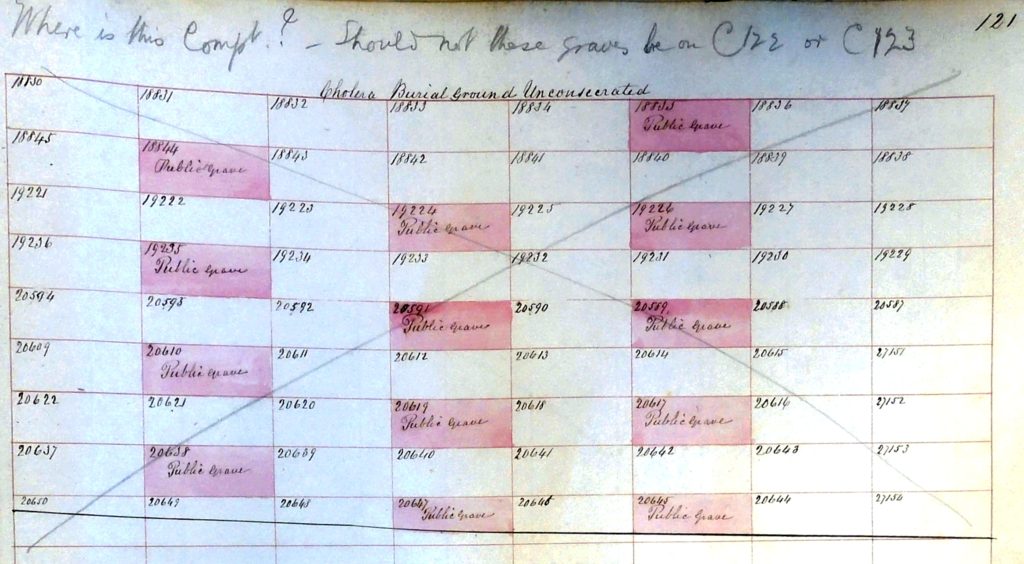
Compartment 121
Let’s look at one of these graves. Grave number 18844 is a public grave. It was first dug for Ann Levitt who died of cholera on September 4th. She was buried that same day. The following day Charles Cheeseman, Elizabeth Gossop and 8 year old Bridget Dunbar joined her. Cholera was the cause of death for all of them. This was the last entry for burials in Compartment 121.
The first burial in Compartment 121 took place on August 12th, grave number 20645. It was filled within two days and a new one opened at 20647. All were cholera deaths.
Now we know that the burials were taking place. They were recorded meticulously by the Cemetery staff at the time. The problem is where are they? The grave numbers do not match any other grave numbers in the cemetery. Quite frankly, they do not exist.
So, we are left with a mystery. Those people were buried in the Cemetery but not in the grave number given, and certainly not in the Compartment 121.
Yes, a clerical error perhaps. I agree with Michael Kelly; they must be in Compartments 122 and 123. I’d just like to know how we could ever find that out.
Over to you to solve this mystery.
Pete Lowden is a member of the Friends of Hull General Cemetery committee which is committed to reclaiming the cemetery and returning it back to a community resource.
